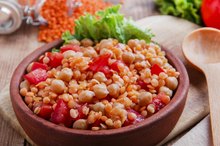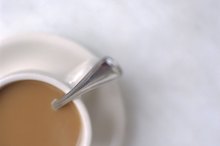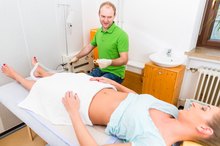What does fact checked mean?
At Healthfully, we strive to deliver objective content that is accurate and up-to-date. Our team periodically reviews articles in order to ensure content quality. The sources cited below consist of evidence from peer-reviewed journals, prominent medical organizations, academic associations, and government data.
- National Digestive Diseases Information Clearinghouse: Cirrhosis
- National Digestive Diseases Information Clearinghouse: Gallstones
The information contained on this site is for informational purposes only, and should not be used as a substitute for the advice of a professional health care provider. Please check with the appropriate physician regarding health questions and concerns. Although we strive to deliver accurate and up-to-date information, no guarantee to that effect is made.
Discomfort After Liver Cleanse
Any detoxification ritual, including a liver cleanse, may illicit a temporary flare-up of illness, according to DoctorOz.com. Following a common, gentle cleanse such as lemon juice and olive oil to flush the liver, you may feel discomfort. Alternative medicine often interprets discomfort positively, as an indication that toxins have vacated the liver, and assumes that it will quickly pass. However, if other symptoms such as pain in the upper abdomen or exhaustion exist, this may mean you have gallstones or cirrhosis, according to the American Gastroenterological Association 23. Consult your doctor or health care practitioner before you undergo a cleanse, and if the discomfort following a liver cleanse includes pain or intense fatigue, be sure to see your physician immediately.
If you are experiencing serious medical symptoms, seek emergency treatment immediately.
Identification
A liver cleanse performed with naturally occurring ingredients such as milk thistle may help remove harmful substances from the liver and rejuvenate any cellular damage therein, according to the UC Berkeley Wellness Guide to Dietary Supplements 4. However, it is important to realize that toxins do not nest in the liver. The liver constantly excretes them, while constantly regenerating itself. Therefore, lasting discomfort following the cleanse, characterized by weakness, loss of appetite or pain in the upper abdomen, between the shoulder blades, or in the right shoulder may denote the early stages of cirrhosis. Also possibly signified by these symptoms could be the presence of gallstones, according to the American Gastroenterological Association 23.
Significance
Liver Itch Detox
Learn More
Prolonged discomfort and pain following a liver cleanse in the general location of the liver -- the upper right quadrant of the abdomen -- may emanate from either the liver or the gallbladder. The liver and the gallbladder work in close concert, and live in close quarters. The gallbladder rests immediately behind the liver. The liver continuously produces and secretes bile, a digestive fluid necessary for the breakdown of fats, which the gallbladder stores between meals, according to the American Gastroenterological Association 23. The liver and the gallbladder connect via the common bile duct, and cirrhosis can occur in cases where the bile duct becomes blocked by gallstones that travel from the gallbladder.
- Prolonged discomfort and pain following a liver cleanse in the general location of the liver -- the upper right quadrant of the abdomen -- may emanate from either the liver or the gallbladder.
- The liver and the gallbladder connect via the common bile duct, and cirrhosis can occur in cases where the bile duct becomes blocked by gallstones that travel from the gallbladder.
Effects
Cirrhosis can cause your skin to turn yellow, a condition known as jaundice, which results from a buildup of bile pigment that normally flows through the liver into the intestines, according to the American Gastroenterological Association 23. Other symptoms may include intense itching caused by bile products accumulating in the skin.
Prevention/Solution
Can Food Sensitivities and Allergies Cause Gallbladder Problems?
Learn More
Liver health depends less on a one-time liver cleanse and more on a diet that consistently includes liver-friendly, naturally detoxifying foods such as:
- broccoli
- cabbage
- spinach
- kale,
- seaweed
According to ShareCare.com, these types of vegetables provide vital enzymes that can assist your liver with the breakdown of foods 5.
Warning
Cirrhosis is an extremely serious health complication, and can lead to liver failure. Gallstone complications sometimes trigger fever, and may lead to a serious infection. If you feel protracted discomfort or pain following a liver cleanse, it is imperative that you see your doctor or health care provider without delay.
Related Articles
References
- DoctorOz.com: Detox Made Safe and Simple
- American Gastroenterological Association: Understanding Cirrhosis
- American Gastroenterological Association Patient Center: Understanding Gallstones
- UC Berkeley Wellness: Be Wary of Liver Supplements
- ShareCare.com: Top 10 Detox Foods
- Liver metastases. Canadian Cancer Society
- Liver cancer symptoms. Cancer Treatment Centers of America
- Gkamprela E, Deutsch M, Pectasides D. Iron deficiency anemia in chronic liver disease: etiopathogenesis, diagnosis and treatment. Ann Gastroenterol. 2017;30(4):405-413. doi:10.20524/aog.2017.0152
- Baraldi O, Valentini C, Donati G, et al. Hepatorenal syndrome: Update on diagnosis and treatment. World J Nephrol. 2015;4(5):511-20. doi:10.5527/wjn.v4.i5.511
- Mazzanti R, Arena U, Tassi R. Hepatocellular carcinoma: Where are we?. World J Exp Med. 2016;6(1):21-36.
- American Society of Clinical Oncology. Cancer.Net. Liver Cancer: Symptoms and Signs. Updated 05/2017. https://www.cancer.net/cancer-types/liver-cancer/symptoms-and-signs
- Bosch, X., Molclus, E., and Escoda, O. et al. Unintentional Weight Loss: Clinical Characteristics and Outcomes in a Prospective Cohort of 2677 Patients. .PLoS One. 2017. 12(4):e0175125.
- Mazzanti, R., Arena, U., and R. Tassi. Hepatocellular Carcinoma: Where Are We? World Journal of Experimental Medicine. 2016. 6(1):21-36.
- National Cancer Institute. Adult Primary Liver Cancer Treatment (PDQ)—Patient Version. Updated 12/07/17. https://www.cancer.gov/types/liver/patient/adult-liver-treatment-pdq
Writer Bio
Emma Cale has been writing professionally since 2000. Her work has appeared in “NOW Magazine,” “HOUR Magazine” and the “Globe and Mail.” Cale holds a Bachelor of Arts in English from the University of Windsor and advanced writing certificates from the Canadian Film Centre and the National Theatre School of Canada.









